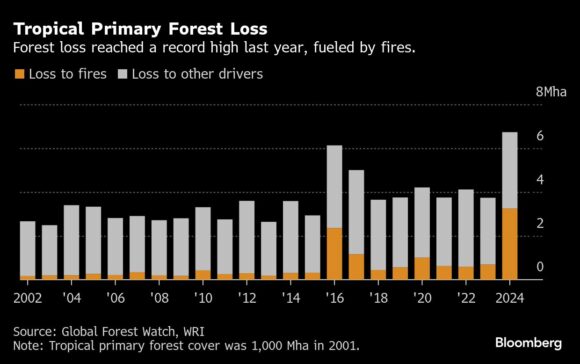Global loss of tropical and boreal forests surged to a record high last year as unprecedented temperatures fueled fires, releasing more than four times the emissions of all air travel in 2023.
That’s according to the latest annual assessment by Global Forest Watch, a platform run by the nonprofit World Resources Institute, which drew on data from the University of Maryland.
“It’s a global red alert,” Elizabeth Goldman, co-director of Global Forest Watch, said in a statement. “This level of forest loss is unlike anything we’ve seen in over 20 years.”
Tropical primary forests, defined as those that have experienced little to no human disturbance, store billions of tons of carbon. They also help regulate weather, recycle water and offer a home to millions of species of plants and animals. At the 2021 United Nations climate conference, COP26, more than 140 nations pledged to halt the loss of all types of forest by the end of the decade.
However, the latest data shows that many of the countries that signed the deforestation pledge are falling woefully short on their commitment. The loss of tropical primary forests reached 6.7 million hectares last year. That’s almost double the loss in 2023 and roughly equivalent to 18 soccer fields disappearing every minute.
Fifteen of the 20 countries with the largest area of primary forests that signed the 2021 forest pledge are now losing trees faster than they were at that time, according to the World Resources Institute.

All of this is occurring after the hottest year on record, with Earth’s warming exceeding 1.5C over pre-industrial levels on an annual basis for the first time. The United Nations has warned that temperatures will continue to rise unless drastic action is taken to curb greenhouse gas emissions. Globally, fires emitted 4.1 billion metric tons of greenhouse gas emissions last year, adding to planetary heating.
Outside of the tropics, fires in Canada and Russia also contributed to the loss of tree cover last year equal to the size of Italy, WRI reported. Tree-cover loss refers to the removal of tree canopy, which is the branches and leaves at the top of a tree.

